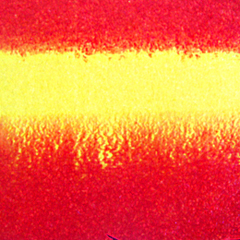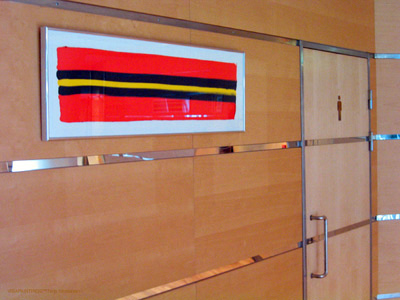an indefinite number of paintings made in a particular manner
Terje’s work, like the situationist dérive, is much more than the roadmovie's mystical credo that ”The journey’s the thing, and anyone who thinks differently is just wasting gas.”(5) Rather, they constitute a process where pleasure and coincidence merge into a description of the nature of the surroundings, and of how movement is defined through these surrounding
THE DÉRIVE IN TERJE NICOLAISENS PRACTICE
Gardar Eide Einarsson
In 1994, I had the idea that i wanted to make a painting for every room at Oslo Plaza Hotel. The hotel had 872 rooms and I started planning the making of the work. Immediately I had the notion that the paintings should be made in a mechanical manner and with a format of approximately 100 by 25 centimetres. They should be made with the speed of visa-cards and in the bright colours of the nations. Hesitating to start this production, I finally arrived at making the first ones the summer of 2000, in the great inspiration and comfort of Pekka Nevalainen, the singing painter.
Acryl on paper, an indefinite number of paintings made in a particular manner.
On display at Sandfjord Politistasjon
In the collection of National Museum, an artist book
Hersay 9: Skulle det begynne å brenne hjemme oss deg, hvilket kunstverk redder du ut av huset?
– Først og fremst harddisker med alle mine egne filmer på. Ellers ville jeg forsøke å redde ut et maleri av Terje Nicolaisen med tittelen Visa painting, et par trykk jeg har fått av min gode venn Erik Pirolt og et eldre trykk med tittelen Bjergeventyr av Louis Moe.
Charlotte Thiis Evensen i magasinet KUNST 13.juli 2017
Ingvild Krogvik:
Several of Nicolaisen’s works criticising the art institution spring from his own situation as an artist. But the personal and private element rarely invades the work itself. The Visa Paintings are typical of this. The whole project derives from the fear of not earning enough money. For Nicolaisen, the counterpart of this fear lay in the dream of the perfect commission, economically speaking – a dream that resulted in a proposal to create a picture for each of the 872 rooms at the Oslo Plaza Hotel. The proposal text (above) is written in a relaxed tone that in no way divulge the existential angst behind it.
Some years later, Nicolaisen realised part of the idea, but the actual Visa Paintings do not bear witness to any existential anguish either. The codes belonging to expressive painting, which traditionally have been read as spontaneous articulations of the artist’s thoughts and feelings, are totally absent. The Visa pictures are, on the contrary, mechanical paintings, where the format, composition and production method are standardised. Liquefied acrylic paint from a bottle has been squeezed out onto the shortest side of a metre-long piece of paper. The paint has then been spread over the paper in one fast stroke, in compliance with the instructions in the textual part of the work: “They should be made with the speed of visa-cards”.
With the advent of concept art, there emerged a belief that the new, dematerialised and site-specific practices would undermine art as a commodity. Two of the main supporters of this belief were the critics and theorists Lucy Lippard and John Chandler, who wrote: “since dealers cannot sell art-as-idea, economic materialism is denied, along with physical materialism.”. However, it rapidly became apparent that snapshots of piles of earth, photocopies, lists of numbers and the other work forms that concept art introduced, could easily be converted into commodities for sale. Nicolaisen’s Visa Paintings were produced nearly three decades after the belief in the conceptual work, merely through its form, could function as a criticism of capitalism, had been undermined. The serious and ideology-burdened critique of the exchange value between art and capital present in early conceptual art is in the Visa Paintings replaced by a completely different mentality. Produced in a way that mimics the act of a Visa-card payment, they could almost appear a tribute to the market forces themselves. But only “almost”, because as is so often the case in Nicolaisen’s art, the whole project ends in a parody – a double-edged parody that not only targets the art collector with his platinum card sticking out of his jacket pocket, but also the poor artist’s utopian dream of a new economic logic where the production and sale of art is as rapid and easy as a direct debit transaction.
Ingvild Krogvik, Utopia As A Critical Tool (excerpt), Terje Nicolaisen: Supplementary Notes 1994 -2011 On Selected Proposals 1995 - 2005 (2011), Henie Onstad Art Centre, Høvik





